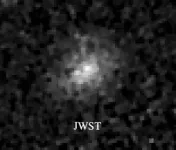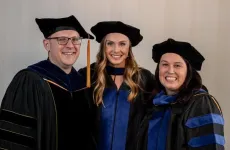(Press-News.org) It first appeared as a glowing blob from ground-based telescopes and then vanished completely in images from the Hubble Space Telescope. Now, the ghostly object has reappeared as a faint, yet distinct galaxy in an image from the James Webb Space Telescope (JWST).
Astronomers with the COSMOS-Web collaboration have identified the object AzTECC71 as a dusty star-forming galaxy. Or, in other words, a galaxy that’s busy forming many new stars but is shrouded in a dusty veil that’s hard to see through — from nearly 1 billion years after the Big Bang. These galaxies were once thought to be extremely rare in the early universe, but this discovery, plus more than a dozen additional candidates in the first half of COSMOS-Web data that have yet to be described in the scientific literature, suggests they might be three to 10 times as common as expected.
“This thing is a real monster,” said Jed McKinney, a postdoctoral researcher at The University of Texas at Austin. “Even though it looks like a little blob, it’s actually forming hundreds of new stars every year. And the fact that even something that extreme is barely visible in the most sensitive imaging from our newest telescope is so exciting to me. It’s potentially telling us there’s a whole population of galaxies that have been hiding from us.”
If that conclusion is confirmed, it suggests the early universe was much dustier than previously thought.
The team published its findings in The Astrophysical Journal.
The COSMOS-Web project — the largest initial JWST research initiative, co-led by Caitlin Casey, an associate professor at UT Austin — aims to map up to 1 million galaxies from a part of the sky the size of three full moons. The goal in part is to study the earliest structures of the universe. The team of more than 50 researchers was awarded 250 hours of observing time in JWST’s first year and received a first batch of data in December 2022, with more coming in through January 2024.
A dusty star-forming galaxy is hard to see in optical light because much of the light from its stars is absorbed by a veil of dust and then re-emitted at redder (or longer) wavelengths. Before JWST, astronomers sometimes referred to them as “Hubble-dark galaxies,” in reference to the previously most-sensitive space telescope.
“Until now, the only way we’ve been able to see galaxies in the early universe is from an optical perspective with Hubble,” McKinney said. “That means our understanding of the history of galaxy evolution is biased because we’re only seeing the unobscured, less dusty galaxies.”
This galaxy, AzTECC71, was first detected as an indistinct blob of dust emission by a camera on the James Clerk Maxwell Telescope in Hawaii that sees in wavelengths between far infrared and microwave. The COSMOS-Web team next spotted the object in data collected by another team using the ALMA telescope in Chile, which has higher spatial resolution and can see in infrared. That allowed them to narrow down the location of the source. When they looked in the JWST data in the infrared at a wavelength of 4.44 microns, they found a faint galaxy in exactly the same place. In shorter wavelengths of light, below 2.7 microns, it was invisible.
Now, the team is working to uncover more of these JWST-faint galaxies.
“With JWST, we can study for the first time the optical and infrared properties of this heavily dust-obscured, hidden population of galaxies,” McKinney said, “because it’s so sensitive that not only can it stare back into the farthest reaches of the universe, but it can also pierce the thickest of dusty veils.”
The team estimates that the galaxy is being viewed at a redshift of about 6, which translates to about 900 million years after the Big Bang.
Study authors from UT Austin are McKinney, Casey, Olivia Cooper (a National Science Foundation graduate research fellow), Arianna Long (a NASA Hubble fellow), Hollis Akins and Maximilien Franco.
Support was provided by NASA through a grant from the Space Telescope Science Institute.
END
Ghostlike dusty galaxy reappears in James Webb Space Telescope image
2023-12-01
ELSE PRESS RELEASES FROM THIS DATE:
A leader in Texas water management
2023-12-01
A University of Texas at Arlington civil engineer is leading a statewide initiative to use more accurate forecasting to guide reservoir storage and release to improve water supply reliability and reduce flood damages.
Yu Zhang, a UT Arlington associate professor in the Department of Civil Engineering, is heading a new project—“Advancing Forecast-Informed Drought Planning for the West Gulf Region Through Integration of Climate Forecasts and Predictions of Reservoir Water Balance Predictions”—funded by the National ...
Public gardens contribute to invasives problem
2023-12-01
Botanist Denis Conover does not have to go far to study the growing problem of invasive plants.
During an autumn stroll outside his office at the University of Cincinnati, the biology professor pointed out numerous examples of nonnative, invasive species in campus landscaping.
“This is winged euonymus, otherwise known as burning bush. And here is Chinese silver grass. It’s a popular ornamental, but the seeds are dispersed by the wind,” he said.
And there were many others: English ivy, wintercreeper, Callery pear.
For his latest study published in the journal Ecological Restoration, he and his students examined the impact ...
Rett patients receive a new gene therapy treatment at Texas Children’s Hospital and Baylor College of Medicine
2023-12-01
Texas Children’s Hospital, an internationally-recognized, top-ranked children’s hospital and pediatric research center affiliated with Baylor College of Medicine, is the first to deliver a novel gene therapy to treat Rett syndrome in pediatric patients. Two female patients with Rett syndrome were the first children worldwide to receive this promising treatment.
This exciting milestone is part of an ongoing first-in-human Phase I/II trial of a new investigational gene therapy, NGN-401, conducted by Neurogene Inc., a clinical-stage company founded to bring life-changing genetic medicines to patients ...
A color-based sensor to emulate skin's sensitivity
2023-12-01
Robotics researchers have already made great strides in developing sensors that can perceive changes in position, pressure, and temperature – all of which are important for technologies like wearable devices and human-robot interfaces. But a hallmark of human perception is the ability to sense multiple stimuli at once, and this is something that robotics has struggled to achieve.
Now, Jamie Paik and colleagues in the Reconfigurable Robotics Lab (RRL) in EPFL’s School of Engineering have developed a sensor that can perceive combinations of bending, stretching, compression, and temperature changes, all using a robust system that boils down ...
SFU researchers sound out Canadian military’s plan to combat ocean noise pollution
2023-12-01
new study from Simon Fraser University researchers examines the Canadian military’s efforts to reduce the impacts of underwater noise pollution on species during training exercises in the Pacific Ocean but caveat that more can still be done.
The paper, published today in Marine Policy, takes aim at a report commissioned by the Canadian Department of National Defence (DND) to reduce the effects of noise pollution from military small-arms munitions training within “Whiskey Hotel”, a 330-square-kilometre ...
Coverage of Bruce Willis’ frontotemporal degeneration shows media misconstrues the disease
2023-12-01
A new paper in Innovation in Aging, published by Oxford University Press, shows that a great deal of media coverage of the actor Bruce Willis’ condition, frontotemporal degeneration, was inaccurate, revealing the public’s limited knowledge of the disease.
In 2022, Willis’ family released a statement saying that he had been diagnosed with aphasia, an acquired language impairment, and would retire from acting. Ten months later, the family issued another statement indicating doctors had diagnosed Willis with a more specific condition, frontotemporal degeneration. ...
Potential pitfalls when using the Cre-LoxP system in cancer research
2023-12-01
“One limitation [of Cre-LoxP], the focus of this editorial, is the potential loss of fidelity of Cre recombinase expression especially in the context of modeling cancer in mice.”
BUFFALO, NY- December 1, 2023 – A new editorial paper was published in Oncoscience (Volume 10) on November 14, 2023, entitled, “Be mindful of potential pitfalls when using the Cre-LoxP system in cancer research.”
In this new editorial, researchers Piotr Czarnota and Jaroslaw Cisowski from Jagiellonian University discuss Cre-LoxP — a widely used system to conditionally modify gene expression in mouse models of cancer and other diseases.
“It ...
CHOP researchers discover deep structural biology connections that help improve CAR therapy
2023-12-01
Philadelphia, December 1, 2023 – Chimeric Antigen Receptors (CARs) have opened up an exciting new field of therapeutic advancements for rare and difficult-to-treat cancers, as they have the ability to deliver targeted therapies that can kill tumor cells. Peptide-centric CARs (PC-CARs) rely on specific peptide “barcodes,” which are derived from proteins within the cell created by potentially cancer-causing oncogenes, are designed to find and target cancer cells. These “barcodes” are displayed by human leukocyte antigens (HLAs), which help the immune system distinguish its own proteins from foreign invaders, ...
Can preeclampsia be prevented?
2023-12-01
NEWS RELEASE
EMBARGOED UNTIL FRI, DEC. 1 -- 2:00 P.M. EASTERN
Contact
Colleen McDonald - Sr. Consultant, Earned Media
414.801.3146 | cmcdonald@mcw.edu
Milwaukee, Wis. – Dec. 1, 2023 – Preeclampsia is a mysterious condition that occurs in about one of 10 pregnancies without any early warning signs. After 20 weeks or more of normal blood pressure during the pregnancy, patients with preeclampsia will begin to experience elevated blood pressure and may also have increased levels of protein in their urine due to hypertension reducing the filtering power of the kidneys. Prolonged hypertension due ...
Meditation training can support wellbeing in older adults
2023-12-01
Following an 18-month meditation programme can improve the wellbeing of older adults, finds a new randomised controlled trial by an international team co-led by UCL.
The findings, published in PLOS ONE, show that meditation can improve people’s awareness, connection to others, and insight.
While the meditation training did not confer significant benefits on two commonly used measures of psychological wellbeing and quality of life, the researchers say their findings may reveal limitations in existing methods of tracking wellbeing.
Lead author Marco Schlosser (UCL Psychiatry and University of Geneva) said: “As the global population ...







